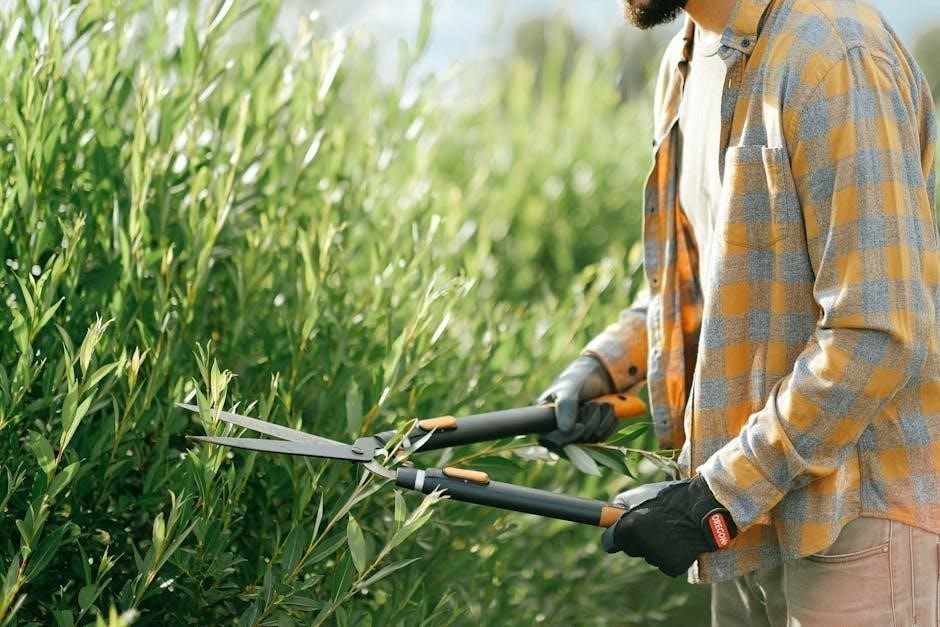A hedge trimmer is an essential gardening tool designed to maintain neat and tidy hedges. Available in manual‚ electric‚ or gas-powered models‚ it ensures precise cutting and shaping. Proper use enhances curb appeal while maintaining plant health. Regular maintenance and safety precautions are crucial for optimal performance and longevity.
1.1 What is a Hedge Trimmer?
A hedge trimmer is a gardening tool designed to cut and shape hedges‚ shrubs‚ and bushes. It typically features blades or cutting bars that trim foliage evenly. Available in manual‚ electric‚ gas-powered‚ or cordless models‚ it offers precision and efficiency for landscaping. Whether for small gardens or large estates‚ a hedge trimmer is essential for maintaining neat‚ well-defined greenery‚ enhancing curb appeal and plant health.
1.2 Importance of Using a Hedge Trimmer
Using a hedge trimmer is crucial for maintaining neat‚ well-defined hedges and shrubs. It enhances curb appeal‚ promotes healthy plant growth‚ and ensures safety by removing overgrown branches. Regular trimming prevents pests and diseases‚ while precise cutting maintains uniform shapes. A good hedge trimmer saves time and effort‚ making it an indispensable tool for gardeners aiming to keep their outdoor spaces manicured and visually appealing year-round.
Types of Hedge Trimmers
Hedge trimmers come in various types‚ each designed for specific tasks. Manual‚ electric‚ gas-powered‚ and cordless models offer precision‚ efficiency‚ and ease of use for different hedge maintenance needs.
2.1 Manual Hedge Trimmers
Manual hedge trimmers are a traditional and eco-friendly option‚ resembling large scissors. They are ideal for small bushes and precise trimming‚ requiring physical effort but offering great control. Lightweight and easy to use‚ they are perfect for detailed work without electricity. These trimmers are cost-effective and suitable for gardeners who prefer a simple‚ non-motorized tool for maintaining small hedges and shrubs.
2.2 Electric Hedge Trimmers
Electric hedge trimmers are lightweight and easy to use‚ offering efficient trimming with minimal effort. They are ideal for small to medium-sized hedges and provide tidy results. Cordless models enhance portability‚ while corded versions ensure consistent power. These trimmers are environmentally friendly and cost-effective‚ making them a popular choice for homeowners. Regular maintenance‚ like blade sharpening‚ ensures optimal performance and longevity of the tool.
2.3 Gas-Powered Hedge Trimmers
Gas-powered hedge trimmers are robust tools designed for heavy-duty trimming tasks. They are ideal for cutting thick branches and large hedges‚ offering more power than electric or manual models. These trimmers are portable and suitable for extensive landscaping. However‚ they require regular maintenance‚ such as oil changes and proper storage. While they are noisy and emit fumes‚ their durability and performance make them a reliable choice for professional gardeners and homeowners with large properties.
2.4 Cordless Hedge Trimmers
Cordless hedge trimmers offer unmatched portability and convenience‚ eliminating the hassle of cords. They are lightweight‚ reducing user fatigue‚ and ideal for small to medium-sized hedges. These trimmers are environmentally friendly‚ producing no emissions‚ and operate quietly. Rechargeable batteries provide reliable power‚ but require proper care to maintain performance. Cordless models are perfect for homeowners seeking ease of use and flexibility in landscaping tasks without compromising on efficiency or precision.

Safety Precautions

Safety is paramount when using hedge trimmers. Always wear protective gear‚ ensure the area is clear of obstacles‚ and keep children away. Proper handling and adherence to guidelines are essential to prevent accidents and ensure safe operation.
3.1 Essential Safety Gear
Protective gear is vital when using hedge trimmers. Wear gloves for grip and hand protection‚ safety glasses to shield eyes from debris‚ and sturdy footwear for stability. Long sleeves and pants can prevent cuts from sharp branches. Ensure all gear fits properly to avoid hindrance. Proper attire minimizes injury risks‚ ensuring safe and effective trimming sessions.
3.2 Pre-Use Safety Checks
Before using a hedge trimmer‚ inspect the blades for sharpness and damage. Ensure all parts are secure and free from debris. Check for loose screws or worn components. For electric or gas-powered models‚ verify the power cord or fuel levels. Clear the area of obstacles and ensure proper assembly. A thorough pre-use check ensures safe operation and prevents potential hazards‚ guaranteeing efficient and effective trimming results every time.
3.3 Safe Operating Practices
Always maintain a firm grip on the handle and keep the trimmer at a comfortable height. Avoid overreaching‚ as this can cause loss of control. Keep children and pets away while operating. Use the trimmer at a steady pace‚ applying gentle to moderate pressure. Never cut near power lines or flammable materials. Ensure the area is clear of debris to prevent accidents. Proper technique ensures safety and achieves professional-looking results.

How to Use a Hedge Trimmer
Start by wearing safety gear and planning your cuts. Hold the trimmer firmly‚ aligning blades with hedge lines. Use smooth‚ steady strokes for even results. Avoid overreaching and keep the area clear of debris for safe‚ precise trimming.
4.1 Step-by-Step Guide to Trimming Hedges
Begin by clearing the area of debris and wearing safety gear. Plan your cuts to maintain even growth. Start at the bottom‚ working upward in small sections. Use smooth‚ steady strokes‚ following the natural shape of the hedge. For taller hedges‚ use a ladder safely. Trim evenly‚ checking progress as you go. Finish by removing clippings and inspecting for neatness. This ensures a professional-looking result every time.
4.2 Tips for Even and Precise Cutting
For even results‚ start with sharp blades and maintain consistent cutting angles. Work in small sections‚ using overlapping strokes to avoid missing spots. Keep the trimmer level for uniform height and use a guide or string for straight lines. Apply gentle pressure to prevent tearing‚ especially on thicker branches. Regularly clean debris from blades to ensure precise cuts and maintain tool efficiency throughout the trimming process.
4.3 Maintaining Posture and Balance
Maintain proper posture by standing upright with feet shoulder-width apart. Hold the trimmer firmly with both hands‚ keeping it at waist height. Avoid overreaching‚ as this can cause imbalance. Move steadily around the hedge‚ stepping back periodically to assess progress. Take regular breaks to rest your arms and prevent fatigue. Proper balance ensures safer‚ more controlled trimming and reduces the risk of accidents or uneven cuts.

Maintenance and Care
Regular maintenance ensures optimal performance. Clean blades after each use‚ sharpen them annually‚ and store the trimmer in a dry place to prevent rust and damage.
5.1 Cleaning the Hedge Trimmer
Cleaning your hedge trimmer is essential for maintaining its performance. After each use‚ remove dirt and debris from the blades using a wire brush. For electric or gas-powered models‚ unplug or turn off the engine before cleaning. Wipe the blades with a damp cloth and dry thoroughly to prevent rust. Regular cleaning ensures sharp cuts and prolongs the tool’s lifespan‚ keeping your hedges neat and well-groomed.
5.2 Sharpening the Blades
Sharpening your hedge trimmer blades is crucial for maintaining cutting efficiency. Use a diamond stone or file to sharpen the blades‚ ensuring the original angle is preserved. Dull blades can damage plants and make trimming difficult. For best results‚ sharpen after cleaning and before storage. Regular sharpening extends blade life and ensures precise cuts. Always sharpen in the same direction as the blade’s edge to avoid damaging the tool.
5.3 Storing the Hedge Trimmer
Proper storage is essential to maintain your hedge trimmer’s condition. Clean and dry the tool thoroughly before storage to prevent rust. Apply a light coat of oil to the blades for protection. Store in a dry‚ secure location‚ away from children. For cordless models‚ remove the battery to prevent drain. Hang or place in a protective cover to avoid damage. Regularly inspect stored trimmers for wear or damage.

Troubleshooting Common Issues
Common issues include dull blades‚ jams‚ and motor problems. Check for debris‚ sharpen blades regularly‚ and ensure proper maintenance to prevent and resolve these issues effectively.
6.1 Dull Blades
Dull blades are a common issue‚ reducing cutting efficiency and causing uneven results. Regular sharpening is essential to maintain sharpness. Use a whetstone or file to sharpen blades carefully. Ensure the trimmer is unplugged before sharpening. Proper technique prevents damage to the blades. Sharpening restores performance and extends the tool’s lifespan. Regular maintenance helps avoid frequent blade replacement and keeps your hedge trimmer functioning effectively.
6.2 Jammed Trimmer
A jammed hedge trimmer can occur due to debris or improper cutting techniques. To resolve this‚ turn off the tool and unplug it. Remove any stuck branches or leaves carefully. Check for blockages in the blade area and clean thoroughly. Apply a small amount of lubricant to moving parts if necessary. Regular maintenance and proper usage can help prevent jams and ensure smooth operation. Always follow safety guidelines when handling a jammed trimmer.
6.3 Motor Issues
Motor issues in hedge trimmers can arise from overheating‚ faulty components‚ or improper use. If the motor stops working‚ turn it off and unplug it immediately. Check for blockages or debris that may be causing strain. Ensure proper ventilation to prevent overheating. Consult the user manual for troubleshooting steps or contact customer support. Regular maintenance‚ such as cleaning and lubricating‚ can help prevent motor problems. Addressing issues promptly ensures longevity and reliable performance.
Choosing the Right Hedge Trimmer
Choosing the right hedge trimmer ensures efficient and safe trimming. Consider hedge size‚ blade length‚ and power source. Manual‚ electric‚ or cordless options suit different needs. Select based on comfort and task requirements. Check reviews for top-rated models to find the best fit for your gardening needs.
7.1 Factors to Consider
When selecting a hedge trimmer‚ consider hedge size‚ blade length‚ and power source. Manual trimmers are ideal for small hedges‚ while electric or cordless models suit larger tasks. Blade length should match hedge thickness. Ergonomic design and weight are crucial for comfort. Check for safety features like blade guards. Budget and maintenance requirements also play a role in making the right choice.
7.2 Recommended Models
Top-rated hedge trimmers include the Ryobi 40V Cordless for versatility‚ B&Q’s NMHT450 for affordability‚ and Stihl HS 61 for professional-grade performance. Ryobi offers excellent battery life and ease of use‚ while B&Q’s model is lightweight and budget-friendly. Stihl’s trimmer is ideal for heavy-duty tasks. Consider your specific needs‚ such as hedge size and type‚ to choose the best model for efficient and precise trimming results.
Advanced Trimming Techniques
Master advanced techniques like shaping hedges‚ trimming large shrubs‚ and creating topiaries. Use precise cuts and maintain even shapes for a polished landscape appearance.

8.1 Shaping Hedges
Shaping hedges requires precision and creativity. Use a hedge trimmer to craft uniform shapes or intricate designs. Start with a clear vision‚ then make precise cuts‚ working from the bottom up. Use a level or guide for symmetry. Regular touch-ups maintain the desired form. Sharp blades ensure clean cuts‚ preventing damage to plants. Practice on small sections before tackling complex designs for professional-looking results.
8.2 Trimming Large Shrubs
Trimming large shrubs requires careful planning and the right tools. Use a long-reach hedge trimmer for tall or deep shrubs; Start at the bottom‚ working upward to maintain visibility. Make precise cuts to avoid tearing branches. Cut in small sections to achieve even results; Regular trimming keeps shrubs healthy and looking their best. Sharp blades ensure clean cuts‚ preventing damage to the plant. This method helps maintain shape and promotes growth.
8.3 Creating Topiaries

Creating topiaries involves shaping shrubs into decorative forms using a hedge trimmer. Start with young‚ flexible plants and use a template or guide for intricate designs. Make precise‚ angled cuts to achieve smooth transitions. Regular trimming maintains the desired shape. Use sharp blades to prevent tearing leaves. Patience and practice are key to mastering this artistic technique‚ transforming hedges into stunning garden features.
Environmental Considerations
Eco-friendly hedge trimmers‚ like battery-powered models‚ reduce carbon emissions. Proper waste disposal and recycling of old trimmers help protect the environment. Sustainable gardening practices promote healthier ecosystems.

9.1 Eco-Friendly Options
Eco-friendly hedge trimmers‚ such as battery-powered and electric models‚ reduce carbon emissions and noise pollution. These options are energy-efficient and promote sustainable gardening practices. Many modern trimmers are designed with recyclable materials‚ minimizing environmental impact.
Choosing cordless or electric trimmers also reduces reliance on fossil fuels; Proper disposal of old trimmers and responsible battery recycling further support environmental conservation. Sharp blades and regular maintenance ensure less waste and cleaner cuts‚ aligning with eco-conscious gardening goals.
9.2 Reducing Waste
Proper disposal of old hedge trimmers and recyclable parts helps minimize environmental impact. Many manufacturers offer recycling programs for batteries and metal components‚ ensuring responsible waste management.
Regular maintenance extends the tool’s lifespan‚ reducing the need for frequent replacements. Additionally‚ eco-friendly models often use sustainable materials‚ further contributing to waste reduction and promoting greener gardening practices.

User Manual Excerpt
Welcome to your hedge trimmer manual! This guide provides detailed instructions for assembly‚ operation‚ and maintenance. Follow safety precautions and warranty information for optimal performance and longevity.
10.1 Assembly Instructions
Begin by carefully unpacking your hedge trimmer and ensuring all components are included. Attach the handle according to the manufacturer’s instructions‚ aligning it securely. Next‚ assemble the blade assembly‚ ensuring it is properly aligned and tightened with the provided screws. Refer to the manual for specific model instructions. Double-check all connections before first use to ensure safety and optimal performance.
10.2 Operating Instructions
Always wear safety gear before starting. Ensure the trimmer is fully assembled and all guards are in place. For electric models‚ plug in and press the safety lock‚ then the trigger. Hold firmly with both hands‚ keeping arms straight. Move the blade in smooth‚ steady strokes‚ following the hedge’s natural shape. Avoid applying too much pressure to prevent stalling. Turn off and unplug before storing or adjusting. Refer to the manual for model-specific guidance.
10.3 Warranty Information
Your hedge trimmer is backed by a limited warranty covering manufacturing defects for a specified period‚ typically 2-5 years. Register your product to validate the warranty. Damage from misuse or wear and tear is excluded. For details‚ refer to the manual or contact the manufacturer. Warranty terms may vary by brand and model‚ ensuring protection for genuine defects in materials and workmanship. Proper maintenance and adherence to guidelines are essential for warranty coverage.
Mastering hedge trimming requires the right tools and practices. By following safety guidelines‚ maintaining equipment‚ and using proper techniques‚ you can achieve professional results and enjoy a well-manicured garden.
11.1 Summary of Key Points
A hedge trimmer is a vital tool for maintaining neat hedges‚ available in manual‚ electric‚ or gas-powered models. Proper use ensures precise cutting and shaping‚ enhancing curb appeal and plant health. Safety gear‚ pre-use checks‚ and safe practices are essential. Regular maintenance‚ like cleaning and sharpening blades‚ prolongs tool life. Advanced techniques‚ such as shaping and topiary‚ require skill and practice. Always follow guidelines for optimal results and longevity of your hedge trimmer.
11.2 Final Tips for Effective Hedge Trimming
Always maintain sharp blades for clean cuts and use the right trimmer for your hedge size. Wear safety gear and ensure proper posture to avoid fatigue. Make steady‚ even strokes and trim in small sections for precision. Regularly clean and store your tool to extend its lifespan. Follow the manual for maintenance and troubleshooting. Practice advanced techniques like shaping for unique designs‚ and consider eco-friendly options for sustainability.

Leave a Reply